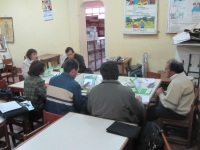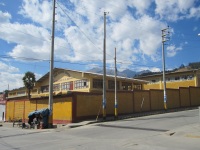While I was in Peru in the first half of August I had a chance to attend two days of a teacher training session in Huaraz. Particularly the 3 hours on the first day turned out to be very interesting and I spent the evenings typing up my thoughts and experiences. Normally I'd keep these notes to myself but I ended up sending them out to a couple of people. Since at least some of them found them useful I decided that it would be worth publishing them here as well.
As a disclaimer please do note that these are indeed very raw and unfiltered impressions written in a sleep- and oxygen-deprived (Huaraz lies at 3000m and I had just arrived from the coast a day earlier) state of mind. I don't claim for these impressions to be representative of how teacher training is done in Peru, rather these are observations at one place at a particular point in time. Take them or leave them. 'nuff said.
Day 1
So the setting was that the start of school was postponed by a week here so the teachers have an extra week of vacation. Don't know whether it was the local UGEL (Unidades de Gestión Educativa Local) or someone else who decided that offering an extra training session for teachers who had previously expressed their interest in more training.
So in the end we had 6 teachers and 1 "especialista" (haven't quite figured out what their role is) in a room with a guy who's a "macro-regional" coordinator for 3 departments. The teachers all came from "uni-docente multi-grado" schools which have been the focus of the first implementation phase here. The size of their schools ranged from 6 to approximately 20 pupils whereby the multi-grado component generally seems to go from 1st through 4th grade (while in generally primary school goes until 6th grade if I'm not mistaken).
One of the teachers works in a school where they don't have electricity to just keeping the XOs charged is a massive hassle. He sometimes takes home his pupils' XOs and charges them there or the pupils go to neighbors in other settlements to charge them. More recently that has stopped though as people have started charging 3 Nuevo Soles (~$1) for allowing pupils to charge their XOs.
The schools of these teachers had all received their XOs approximately one year ago. At that time they also received a 5-day training which they all agreed on wasn't nearly enough.
Anyway, the session itself started around 3:30PM and lasted approximately 2 1/2 hours. The first half hour or so was spent demonstrating how to re-flash and re-activate an XO since people often run into issues which require these steps.
The next 45min were dedicated to:
- how to change the name from the command-line (via the Terminal Activity) since build 703 which they're using in Peru doesn't have the Control Panel to facilitate that step and with changing pupils this needs to be done quite regularly
- set the date via the command-line since (if I remember correctly) an issue causes the XOs to forget it which leads to activation issues and whatnot

Teacher training in session
The next step was a joint Chat session with an associated introduction into the Neighborhood View, networks and Internet (or lack thereof since none of the schools in the region have connectivity at the moment). Of course this ended with the teachers finding themselves on two different Mesh channels and hence in two Chat sessions.
The last 30min were spent with eToys whereby the teachers made a story-book consisting of text, a drawing and an audio recording.
The coordinator did a good job in my opinion and seemed to know his way around the XO and the activities quite well even though he only started working on the project in May.
I happened to have a copy of the "Manual básico de uso de XO" that volunteers in Uruguay had created on me and showed it to the group at the end of the session. They were very excited and ended up going to a copy-shop so everyone could get their copy.
I was also asked whether I knew of more materials that could be of use to them and so I'm currently downloading the things listed on the Recursos en espanol wiki-page so I can pass them on to them on a USB drive tomorrow. I was particularly surprised that none of them had heard about Sdenka Salas' "La Laptop XO en el Aula" given that to me it seems like the Peruvian bible of XO use. (On a related note Sdenka invited me to come to visit her in Puno but unfortunately I won't have time to do that this time 'round.)
Day 2
In the second day's session they spent more than an hour working with Scratch to create and animate a story. Before that they spent an hour playing around with TamTam Mini and TamTam Jam. It was an enjoyable experience and I even got quite good at playing "El condor pasa";-)
Contrary to yesterday today there was also some (superficial IMHO) talk about how to integrate the Activities under discussion in the classroom.
With regard to a discussion about learning and reflection I can only say that it didn't happen in the two days that I attended. 98% of the time was really focused on learning how to use the Activities themselves with the remaining time going towards how they could be used in class.



Christoph,
Really interesting to read this. We are facing the same problem in rural Uruguay for our project, lacking electricity. On one school they just ignore the laptops because of that, another teacher decides to carry a bulk of XOs to her house to charge them.
Keep up the posts, I definitely consider them useful. Thanks for sharing!
Uruguay and Peru bringing laptops to schools before electricity reminds me of the guy waiting for public transportation with a $5,000 Rolex firmly perched on his wrist.
Sad.